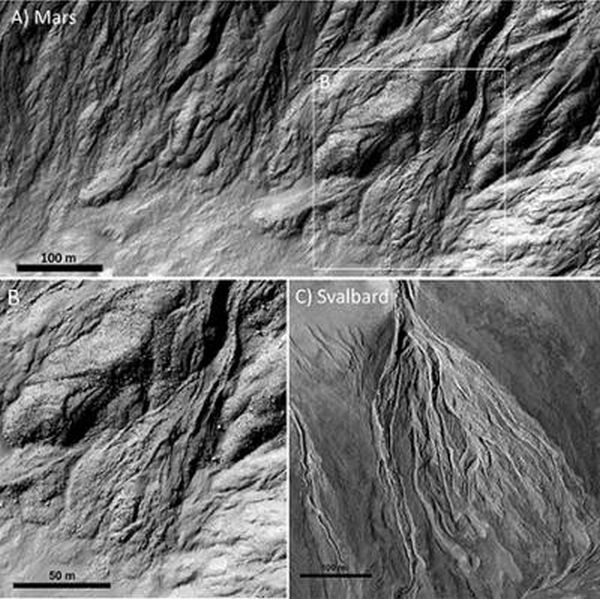According to a recent study, researchers claim that Mars had liquid water, as recent as 200,000 years ago. In southern mid latitudes of Mars, a young crater has been discovered. Researchers say that this crater has well conserved gorge and debris of sediments created by flowing liquid water. The geomorphological feature of these formations furnishes evidence that the action of flowing water had created them in recent geological time.
Proof of Liquid Water
Debris starts flowing when sediment (which is a mixture of soil, water, clay and rock) lying on a slope gets sodden with water. This makes the mixture extremely heavy to stay in place and start to flow rapidly down the slope as a single phase unit, known as debris flow, quite similar to landslides that occur on Earth and causing human casualties and damage to properties. When this mixture of sediment and water halts, it exhibits the typical surface traits as lobate accumulation and paired levees alongside flow channels.
Andreas Johnsson, who is the lead author of the study, has identified these landforms on the Mars surface. Andreas and a team of researchers from the University of Gothenburg, using aerial photography and field studies, compared landforms on Mars with Svalbard debris flows. The flow of debris on Mars proved that liquid water was once present in that region.
The fieldwork conducted in Svalbard helped researchers to explain about the deposits found. Researchers were surprised with the fact that the crater, that had the evidence of debris flow was formed recently.
Following the Ice Age
Andrea and his team using crater statistics judged that nearly 200,000 years back the crater was formed. This implies that the formation of crater took place much after the end of last ice age on Mars, which was around 400,000 years ago. There are many other gorges on the Mars surface and sediment deposits in them are associated with the latest ice age. However, this newly found crater is too new to be affected by the conditions that were present during the last ice age. This finding proposes that the process related to meltwater, that created these deposits have been effective in recent times.
Affect on Wet Ground
The crater located in the southern hemisphere of Mars along the mid latitudes that the researchers are studying, overlapped with an adjoining crater known as the rampart ejecta. And around the host crater, rampart ejecta exhibit a flowerlike formation caused by an impact in wet or ice rich ground as interpreted by researchers.
Experts first believed that the preserved ice inside the rampart ejecta might be the source of water for debris flows. But there were no cracks or fractures of the crater surface that might have acted as a channel for the meltwater. This suggests that melting snow packs was the reason behind water availability. During that period, the conditions were also suitable for snow formation than now, because then Mars was more tilted around its orbital axis as compared to today’s times, added Andreas.
Source: AlphaGalileo




